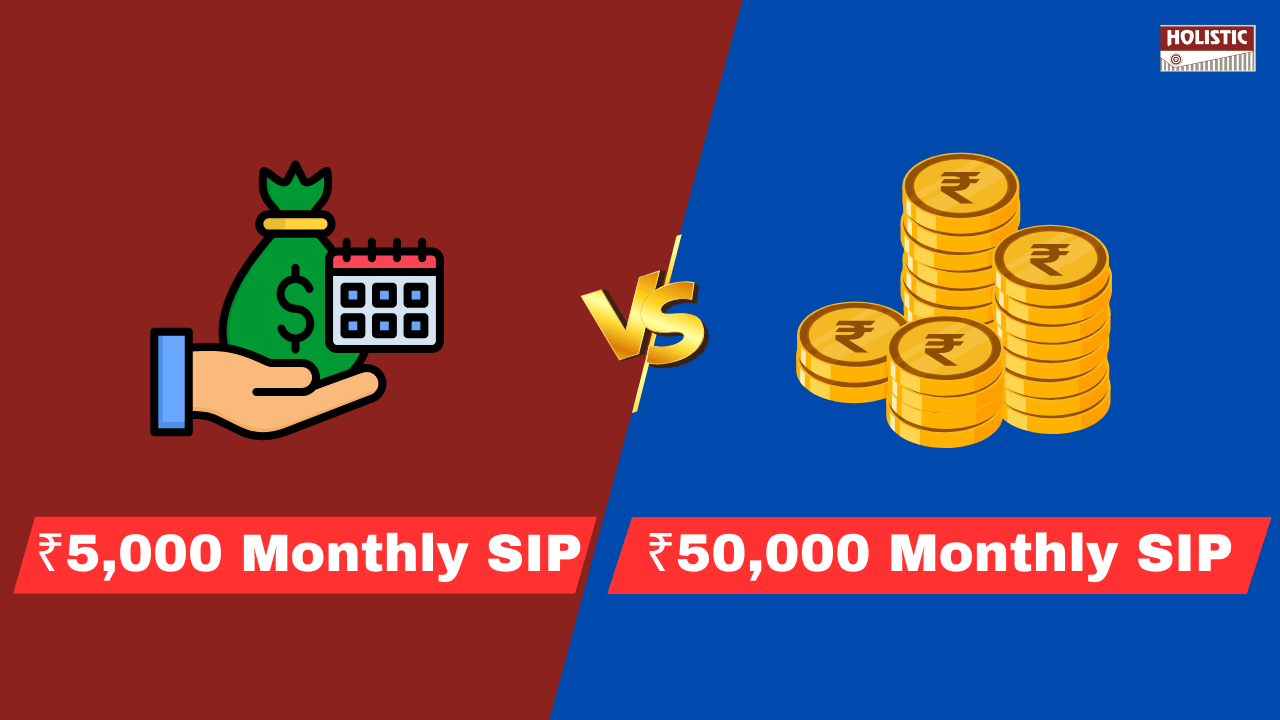When it comes to investing, we often face this fundamental question: “Is it better to invest smaller amounts consistently over time or make larger investments for a shorter period?”
It’s a question that many of us struggle with, especially when we think about how much to invest and how long to keep at it.
But what if the real secret lies not just in how much you invest, but in how long you stay invested?
Let’s explore a comparison between two SIP strategies and see what gives you the higher return in the long run.
Table of Contents:
- Can Small Investments Over Time Beat Larger Investments in the Short Term?
- What Will ₹5,000 Monthly SIP for 33 Years Yield?
- What If You Invest ₹50,000 Monthly for 15 Years Instead?
- What Will ₹50,000 Monthly SIP for 15 Years Yield?
- Is Time the Real Winner in Investment?
- The Final Takeaway: Time is Your Best Friend
Can Small Investments Over Time Beat Larger Investments in the Short Term?
Imagine this: you begin with ₹5,000 a month and stick to this plan for 33 years. It may sound like a modest start, but over the years, you may be surprised by how much this relatively small amount can grow.
What Will ₹5,000 Monthly SIP for 33 Years Yield?
- Investment Duration: 33 years
- Monthly SIP: ₹5,000
- Total Investment: ₹5,000 × 12 × 33 = ₹19,80,000
- Future Value (12% Annualized Return): ₹2,54,69,990
With compounding working in your favour, even a modest ₹5,000 monthly investments over three decades can grow into a corpus of ₹2.54 crore. So, what’s the catch? It’s all about time.
The longer you invest; the more powerful compounding becomes. But how does this compare to making a higher investment over a shorter period? Let’s take a look.
What If You Invest ₹50,000 Monthly for 15 Years Instead?
Now, what if you decided to go big? Imagine investing ₹50,000 every month for just 15 years. You’re investing 10 times more per month, but the duration is significantly shorter.
Does this strategy lead to a higher corpus, or does time still trump money?
What Will ₹50,000 Monthly SIP for 15 Years Yield?
- Investment Duration: 15 years
- Monthly SIP: ₹50,000
- Total Investment: ₹50,000 × 12 × 15 = ₹90,00,000
- Future Value (12% Annualized Return): ₹2,52,28,800
Here, with a much higher monthly SIP, you end up investing ₹90 lakh in total. However, the shorter duration means you won’t get the benefit of as much compounding, and the resulting corpus is ₹2.52 crore.
Is Time the Real Winner in Investment?
So, what have we learned from these two scenarios? Does investing more money really mean a bigger return? Not necessarily. Here’s the breakdown:
- ₹5,000 monthly for 33 years grows to ₹2.54 crore with a total investment of just ₹19.8 lakhs.
- ₹50,000 monthly for 15 years grows to ₹2.52 crore, but with a hefty total investment of ₹90 lakhs.
Which one would you prefer?
The strategy that focuses on small, consistent investments over a longer time or one that demands large contributions but shortens your window for growth?
The Final Takeaway: Time is Your Best Friend
Here’s the golden rule: The longer you stay invested; the more powerful compounding becomes.
Starting small and sticking with your investment plan can sometimes lead to far better results than a higher contribution over a shorter span.
Why? Because the key to building wealth is not just about how much you put in, but how long you let it grow.
Remember, the power of compounding is what makes the magic happen. And when it comes to building wealth, Time really is King.
Why wait? Start your SIP today and build your dream Financial Future for Tomorrow.





